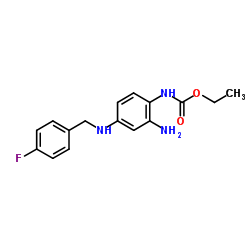Retigabine: chemical synthesis to clinical application.
G Blackburn-Munro, W Dalby-Brown, N R Mirza, J D Mikkelsen, R E Blackburn-Munro
Index: CNS Drug Rev. 11(1) , 1-20, (2005)
Full Text: HTML
Abstract
Retigabine [D23129; N-(2-amino-4-(4-fluorobenzylamino)-phenyl)carbamic acid ethyl ester] is an antiepileptic drug with a recently described novel mechanism of action that involves opening of neuronal K(V)7.2-7.5 (formerly KCNQ2-5) voltage-activated K(+) channels. These channels (primarily K(V)7.2/7.3) enable generation of the M-current, a subthreshold K(+) current that serves to stabilize the membrane potential and control neuronal excitability. In this regard, retigabine has been shown to have a broad-spectrum of activity in animal models of electrically-induced (amygdala-kindling, maximal electroshock) and chemically-induced (pentylenetetrazole, picrotoxin, NMDA) epileptic seizures. These encouraging results suggest that retigabine may also prove useful in the treatment of other diseases associated with neuronal hyperexcitability. Neuropathic pain conditions are characterized by pathological changes in sensory pathways, which favor action potential generation and enhanced pain transmission. Although sometimes difficult to treat with conventional analgesics, antiepileptics can relieve some symptoms of neuropathic pain. A number of recent studies have reported that retigabine can relieve pain-like behaviors (hyperalgesia and allodynia) in animal models of neuropathic pain. Neuronal activation within several key structures within the CNS can also be observed in various animal models of anxiety. Moreover, amygdala-kindled rats, which have a lowered threshold for neuronal activation, also display enhanced anxiety-like responses. Retigabine dose-dependently reduces unconditioned anxiety-like behaviors when assessed in the mouse marble burying test and zero maze. Early clinical studies have indicated that retigabine is rapidly absorbed and distributed, and is resistant to first pass metabolism. Tolerability is good in humans when titrated up to its therapeutic dose range (600-1200 mg/day). No tolerance, dependence or withdrawal potential has been reported, although adverse effects can include mild dizziness, headache, nausea and somnolence. Thus, retigabine may prove to be useful in the treatment of a diverse range of disease states in which neuronal hyperexcitability is a common underlying factor.
Related Compounds
| Structure | Name/CAS No. | Molecular Formula | Articles |
|---|---|---|---|
 |
Retigabine
CAS:150812-12-7 |
C16H18FN3O2 |
|
Enhanced in vitro CA1 network activity in a sodium channel β...
2014-04-01 [Epilepsia 55(4) , 601-8, (2014)] |
|
Safety profile of two novel antiepileptic agents approved fo...
2013-11-01 [Expert Opin. Drug Saf. 12(6) , 847-55, (2013)] |
|
Ezogabine (retigabine) and its role in the treatment of part...
2012-09-01 [Clin. Ther. 34(9) , 1845-56.e1, (2012)] |
|
[Retigabine - a new antiepileptic drug with a different mech...
2013-01-01 [Postepy. Hig. Med. Dosw. 67 , 973-81, (2013)] |
|
P-retigabine: an N-propargyled retigabine with improved brai...
2015-01-01 [Mol. Pharmacol. 87(1) , 31-8, (2015)] |